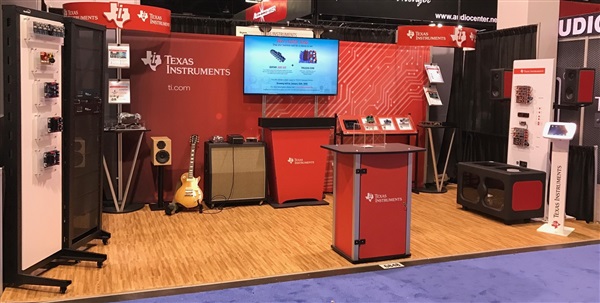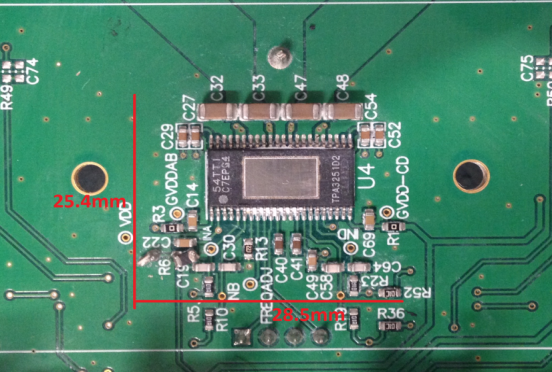SSZTAC8 march 2017 TPA3245 , TPA3251 , TPA3255
Guitars, drums, cymbals … the 2017 National Association of Music Merchants (NAMM) Show had it all, but what seemed to be making the most noise was the professional audio gear.
I’ve heard a lot about the NAMM Show, the largest music gear conference in the U.S. (probably the world), and my excitement attending for the first time was hard to contain. The music world from musicians, to mastering and mixing engineers, all come together to see the latest instruments and equipment the industry has to offer.
Of course, the major guitar and professional audio equipment manufacturers you would expect at this show had the largest booths, but that didn’t keep other exhibitors from showing some cool equipment as well.
For us at Texas Instruments, this was our first year exhibiting at NAMM, although it was hardly our first year designing audio components (audio amplifiers and digital-to-analog converters) for the professional audio and music industry. For 2017, we had a lot to show around our new family of fully integrated high-performance Class-D amplifiers. Here is our booth the night before the show, ready with multiple demos showcasing our new Class-D amplifier family (Figure 1).
 Figure 1 Texas Instruments’ Booth at
the 2017 NAMM Show
Figure 1 Texas Instruments’ Booth at
the 2017 NAMM ShowWalking through the guitars was great, but I was really there to see the latest with speakers and amplifiers. Everyone was offering speakers with more power and more integration. Below is a short list of some of the cool products exhibitors showed at NAMM:
- A new Class-D guitar amp with the same sound and style you would expect, but at about half the size. It also had a cool Bluetooth® app for controlling the sound tone and character.
- A new connected PA speaker system that recalled instrument settings, speaker levels and EQs through a smartphone app. The speaker they used was equipment from their powered loudspeaker lineup.
- Studio monitors were in full force, with multiple manufacturers offering products with amazing performance using the latest Class-D technology.
What continued to be a trend in the professional audio space were speakers designed with audio amplifiers inside. I heard from numerous speaker designers that it’s easier to match an amplifier and speaker during the design phase, and it’s also easier for sound engineers to use.
I received similar feedback about TI’s Class-D amplifiers. We had a variety of demos including powered speakers, a guitar amplifier and a Dolby Atmos sound bar that all used our new TPA3255 family of integrated high-power amplifiers. After about the third day, I had heard many people stop by our booth and mention that they had never considered a fully integrated chip solution. Most designers today use audio amplifier modules, which are pre-built printed circuit boards (PCBs) with discrete component amplifiers. Yet there are many benefits to using an integrated chip instead, including:
- Protection. An integrated chip offers the same level of protection as amplifier modules, with overcurrent, thermal and short-circuit protection.
- Ease of design. The integrated option is easy to add to your existing pre-amplifier board. Simply add the amplifier chip, output filter, and a few components for settings and control.
- Size. The integrated solution can offer a reduction in size because the protection, audio-loop circuitry and auxiliary power rails are all built right into the device. See the solution size in Figure 2.
- Reliability. There are only a few components on the board, which decreases the failure rate. In addition, the chip is backed by TI’s long history of integrated circuit design and testing standards.
- Thermal. As with any Class-D, you get the benefit of improved efficiency and reduced heat-sink size. An additional benefit of an integrated solution is that you only have one device that you need to heat sink, so system design and mass production assembly become easier as well.
- Component selection. With an integrated chip, you have the flexibility to choose the best-quality or best-value components like capacitors and inductors to optimize for your system goals.
 Figure 2 TPA3255 600W Class-D Audio
Amplifier
Figure 2 TPA3255 600W Class-D Audio
AmplifierWith TI’s new family of Class-D audio amplifiers, you can get even more out of your amplifier:
- Power levels as high as 600W.
- Better audio dynamics, with a dynamic range >111dB.
- Audio performance as good as or better than a Class-AB amplifier, with total harmonic distortion plus noise (THD+N) below 0.01% all the way to clipping.
- Design flexibility to add external tuning and feedback circuits, allowing you to tune the device to your signature sound.
- The new family’s five pin-compatible power levels mean that you can use the same design for all of your speaker power levels but use different power-level chips.
To be honest, it was difficult to hear much by the end of the show. We even measured the exhibition hall’s noise level at around 80dB – just short of standing next to a blender for eight hours each day. However, I would encourage everyone to have a listen to the TPA3255 series of Class-D amplifiers. Let us know how it sounds and if it would fit well in your application.
Additional Resources
- Start designing quickly with the TPA3255 evaluation module (EVM).
- To help select the right external components for your system, download the Device Setup Guide & Configuration Tool for the TPA3251, TPA3255 and TPA3245 devices. Select your output configuration and parameters and use the suggested values as a guideline for development.
- Calculate and design audio Class-D LC filters in minutes using the Class-D LC Filter Designer.
- Read these application notes from our audio experts:
- To learn more about high-power Ultra-HD Class-D audio amplifiers, visit TI.com/highpoweraudio.
Save